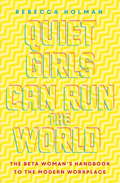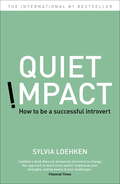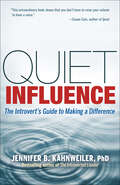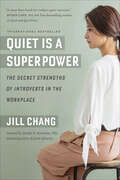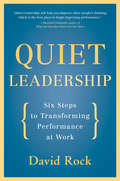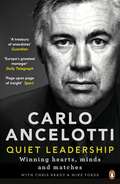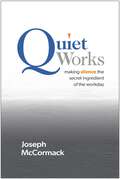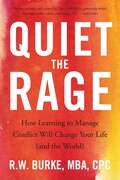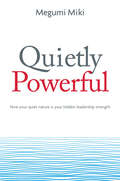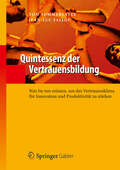- Table View
- List View
Quiet Girls Can Run the World: The beta woman's handbook to the modern workplace
by Rebecca HolmanWhat does success look like? 5AM conference calls and late nights in the office? Winning every argument in the office and always getting your own way? What does a successful woman look like? The shoulder-pad wearing Alpha? The dogmatist who rules with an iron fist? The reality is far more nuanced. Yet women are still reduced to Alpha boss, or the Beta secretary or assistant but when 47% of the workforce are reduced to two unhelpful stereotypes, how can you embrace your inner Beta and be a success on your own terms? It's an important question because the world is changing, fast. Successful companies need people who can lead with emotional intelligence, be flexible to new ideas and adapt their plans when required, leaving their ego at the door. The Beta woman's time is now. Beta celebrates the collaborators, the pragmatists, and the people who believe that being nice works and getting your own way isn't always the most important thing. It explores the unsung workforce of Beta women who are being great bosses, great leaders and are still living their own lives: having relationships, making time for friends, having families. Fully researched and rich with interviews, anecdotes and case studies, Beta will be a smart and entertaining read that really explores the role of women in the workplace today.
Quiet Girls Can Run the World: The beta woman's handbook to the modern workplace
by Rebecca HolmanWhat does success look like? 5AM conference calls and late nights in the office? Winning every argument in the office and always getting your own way? What does a successful woman look like? The shoulder-pad wearing Alpha? The dogmatist who rules with an iron fist? The reality is far more nuanced. Yet women are still reduced to Alpha boss, or the Beta secretary or assistant but when 47% of the workforce are reduced to two unhelpful stereotypes, how can you embrace your inner Beta and be a success on your own terms? It's an important question because the world is changing, fast. Successful companies need people who can lead with emotional intelligence, be flexible to new ideas and adapt their plans when required, leaving their ego at the door. The Beta woman's time is now. Beta celebrates the collaborators, the pragmatists, and the people who believe that being nice works and getting your own way isn't always the most important thing. It explores the unsung workforce of Beta women who are being great bosses, great leaders and are still living their own lives: having relationships, making time for friends, having families. Fully researched and rich with interviews, anecdotes and case studies, Beta will be a smart and entertaining read that really explores the role of women in the workplace today.
Quiet Girls Can Run the World: The beta woman's handbook to the modern workplace
by Rebecca HolmanEmbrace your inner Beta and get ahead - on your own terms.What does success look like? 5AM conference calls and late nights in the office? Winning every argument in the office and always getting your own way? What does a successful woman look like? The shoulder-pad wearing Alpha? The dogmatist who rules with an iron fist? The reality is far more nuanced. Yet women are still reduced to Alpha boss, or the Beta secretary or assistant but when 47% of the workforce are reduced to two unhelpful stereotypes, how can you embrace your inner Beta and be a success on your own terms? It's an important question because the world is changing, fast. Successful companies need people who can lead with emotional intelligence, be flexible to new ideas and adapt their plans when required, leaving their ego at the door. The Beta woman's time is now. Beta celebrates the collaborators, the pragmatists, and the people who believe that being nice works and getting your own way isn't always the most important thing. It explores the unsung workforce of Beta women who are being great bosses, great leaders and are still living their own lives: having relationships, making time for friends, having families. Fully researched and rich with interviews, anecdotes and case studies, Beta will be a smart and entertaining read that really explores the role of women in the workplace today.(P)2017 Hodder & Stoughton Limited
Quiet Impact: How to be a successful Introvert
by Sylvia LoehkenMost literature on business, communication and success is focused on extroverts, who feel comfortable networking, talking and being the centre of attention. But at least 30% of the population are introverts, and they are now finding their voice. Quiet Impact - How to Be a Successful Introvert is already an international phenomenon. Using the latest psychological research, and Dr Loehken's own extensive experience coaching introverts in the workplace, it is packed with practical advice which is easy to implement. Dr Loehken identifies 10 strengths specific strengths that introverts often have (such as independence, perseverance and writing), and also identifies ten specific hurdles they often have to overcome (such as hyperstimulation, intellectualism and fear of conflict).
Quiet Impact: How to be a successful Introvert
by Sylvia LoehkenMost literature on business, communication and success is focused on extroverts, who feel comfortable networking, talking and being the centre of attention. But at least 30% of the population are introverts, and they are now finding their voice.Quiet Impact - How to Be a Successful Introvert is already an international phenomenon. Using the latest psychological research, and Dr Loehken's own extensive experience coaching introverts in the workplace, it is packed with practical advice which is easy to implement.Dr Loehken identifies 10 strengths specific strengths that introverts often have (such as independence, perseverance and writing), and also identifies ten specific hurdles they often have to overcome (such as hyperstimulation, intellectualism and fear of conflict).
Quiet Influence: The Introvert's Guide to Making a Difference
by Jennifer KahnweilerIntroverts may feel powerless in a world where extroverts seem to rule, but there's more than one way to have some sway. As Jennifer Kahnweiler proves in this much-needed book, introverts can be highly effective influencers when, instead of trying to act like extroverts, they use their natural strengths. Kahnweiler shows how you can use those strengths to challenge the status quo, provoke new ways of thinking, effect change, and inspire others to move forward. Kahnweiler identifies six unique strengths introverts have: * Taking Quiet Time: The periods of solitude that introverts crave provide them with a powerful source of creativity and self-awareness. * Preparation: Careful preparation, which makes introverts feel more comfortable, also makes them very knowledgeable and able to anticipate objections. * Writing: Introverts' preference for writing over speaking enables them to influence others through deep, authentic, well-developed arguments. * Engaged Listening: Introverts are great listeners--they'd rather listen than talk--which is a crucial skill for establishing rapport and mutual understanding. * Focused Conversation: Introverts don't like small talk, but they excel at the serious, purpose-driven, one-on-one interactions vital for winning people over. * Thoughtful Use of Social Media: Oversharing doesn't appeal to introverts online any more than it does offline, so they naturally use social media in a thoughtful, and more effective, way. Kahnweiler includes a Quiet Influence Quotient quiz to measure how well you're using these six strengths now. Then, through questions, tools, exercises, and real-world examples, she helps you increase your mastery of these strengths. Quiet Influence is the must-have guide to deeper insight and greater impact that introverts have been waiting for and that extroverts can learn from. "This extraordinary book shows that you don't have to raise your volume to have a voice." --Susan Cain, author of Quiet: The Power of Introverts in a World That Can't Stop Talking
Quiet Is a Superpower: The Secret Strengths of Introverts in the Workplace
by Jill Chang&“Jill is living proof that introverts can thrive in the workplace. . . . A must-have book for today&’s quiet warriors.&” —Susan Cain, New York Times–bestselling author of Quiet and Quiet Power How does a self-described &“extreme introvert&” thrive in a world where extroverts are rewarded and social institutions are set up in their favor? Using her extraordinary personal story, Jill Chang shows that introverts hold tremendous untapped potential for success. Chang describes how she succeeded internationally in fields that are filled with extroverts, including as an agent for Major League Baseball players, a manager of a team across more than twenty countries, and a leading figure in international philanthropy. Instead of changing herself, she learned to embrace her introversion, turning it from a disadvantage to the reason she was able to accomplish great goals. She offers advice on the best jobs for introverts, overcoming the additional difficulties language and cultural barriers can present, thriving at social events and business presentations, leveraging the special leadership traits of introverts, and much more. Part memoir and part career guide, this book gives introverts the tools to understand how they can form relationships, advance in the career path, excel in cross-cultural workplaces, and navigate business settings without compromising comfort or personality. &“Readers will find this book both practical and inspiring.&” —Jennifer B. Kahnweiler, PhD, author of The Introverted Leader, Quiet Influence, and The Genius of Opposites &“Chang provides solid strategies to help . . . introverts shine in their own quiet way.&” —Sophia Dembling, author of The Introvert&’s Way and Introverts in Love &“An invaluable resource.&” —Laurie Helgoe, PhD, author of Introvert Power
Quiet Leadership
by David RockImproving the performance of your employees involves one of the hardest challenges in the known universe: changing the way they think. In constant demand as a coach, speaker, and consultant to companies around the world, David Rock has proven that the secret to leading people (and living and working with them) is found in the space between their ears. "If people are being paid to think," he writes, "isn't it time the business world found out what the thing doing the work, the brain, is all about?" Supported by the latest groundbreaking research, Quiet Leadership provides a brain-based approach that will help busy leaders, executives, and managers improve their own and their colleagues' performance. Rock offers a practical, six-step guide to making permanent workplace performance change by unleashing higher productivity, new levels of morale, and greater job satisfaction.
Quiet Leadership
by David RockImproving the performance of your employees involves one of the hardest challenges in the known universe: changing the way they think. In constant demand as a coach, speaker, and consultant to companies around the world, David Rock has proven that the secret to leading people (and living and working with them) is found in the space between their ears. "If people are being paid to think," he writes, "isn't it time the business world found out what the thing doing the work, the brain, is all about?" Supported by the latest groundbreaking research, Quiet Leadership provides a brain-based approach that will help busy leaders, executives, and managers improve their own and their colleagues' performance. Rock offers a practical, six-step guide to making permanent workplace performance change by unleashing higher productivity, new levels of morale, and greater job satisfaction.
Quiet Leadership
by David RockImproving the performance of your employees involves one of the hardest challenges in the known universe: changing the way they think. In constant demand as a coach, speaker, and consultant to companies around the world, David Rock has proven that the secret to leading people (and living and working with them) is found in the space between their ears. "If people are being paid to think," he writes, "isn't it time the business world found out what the thing doing the work, the brain, is all about?" Supported by the latest groundbreaking research, Quiet Leadership provides a brain-based approach that will help busy leaders, executives, and managers improve their own and their colleagues' performance. Rock offers a practical, six-step guide to making permanent workplace performance change by unleashing higher productivity, new levels of morale, and greater job satisfaction.
Quiet Leadership: Winning Hearts, Minds and Matches
by Carlo AncelottiCarlo Ancelotti is one of the greatest managers of all time, with five Champions League titles to his name. Yet his approach could not be further from the aggressive theatricals favoured by many of his rivals. His understated style has earned him the fierce loyalty of players like David Beckham, Zlatan Ibrahimovic and Cristiano Ronaldo.In Quiet Leadership, Ancelotti reveals the full, riveting story of his managerial career - his methods, mentors, mistakes and triumphs - and takes us inside the dressing room to trace the characters, challenges and decisions that have shaped him. The result is both a scintillating memoir and a rare insight into the business of leadership.
Quiet Logistics (A)
by Natalie Kindred Robert L. SimonsThis two-part case focuses on how to identify and manage strategic uncertainties in an innovative, entrepreneurial start-up company. In the (A) case, students learn about Quiet Logistics, an e-commerce fulfillment company working with high-end apparel retailers such as Bonobos, Gilt Groupe, and Zara. What distinguishes the company from its rivals is its use of Kiva robots which collect customer items within the warehouse and bring them to the appropriate work station for employees to package and prepare for shipment. Processing up to 8,000 orders per day, the robots help make Quiet Logistics a highly-efficient firm and free its workers to complete additional value-added services such as handwritten thank-you notes. The company has also developed proprietary software to collect data on productivity measures, resulting in 99.99% accuracy in its inventory system and completing orders on-time. At the end of the (A) case, students are asked to list the strategic uncertainties that should be keeping the two co-founders awake at night as they consider growth opportunities for their company.
Quiet Logistics (B)
by Natalie Kindred Robert L. SimonsThis two-part case focuses on how to identify and manage strategic uncertainties in an innovative, entrepreneurial start-up company. In the (A) case, students learn about Quiet Logistics, an e-commerce fulfillment company working with high-end apparel retailers such as Bonobos, Gilt Groupe, and Zara. What distinguishes the company from its rivals is its use of Kiva robots which collect customer items within the warehouse and bring them to the appropriate work station for employees to package and prepare for shipment. Processing up to 8,000 orders per day, the robots help make Quiet Logistics a highly-efficient firm and free its workers to complete additional value-added services such as handwritten thank-you notes. The company has also developed proprietary software to collect data on productivity measures, resulting in 99.99% accuracy in its inventory system and completing orders on-time. At the end of the (A) case, students are asked to list the strategic uncertainties that should be keeping the two co-founders awake at night as they consider growth opportunities for their company.
Quiet Politics and Business Power
by Pepper D. CulpepperDoes democracy control business, or does business control democracy? This study of how companies are bought and sold in four countries - France, Germany, Japan, and the Netherlands - explores this fundamental question. It does so by examining variation in the rules of corporate control - specifically, whether hostile takeovers are allowed. Takeovers have high political stakes: they result in corporate reorganizations, layoffs, and the unraveling of compromises between workers and managers. But the public rarely pays attention to issues of corporate control. As a result, political parties and legislatures are largely absent from this domain. Instead, organized managers get to make the rules, quietly drawing on their superior lobbying capacity and the deference of legislators. These tools, not campaign donations, are the true founts of managerial political influence.
Quiet Works: Making Silence the Secret Ingredient of the Workday
by Joseph McCormackWe live—and work—in a world of nonstop noise. It&’s time to reimagine how we work and make silence the secret ingredient. From the time we wake up, our workday starts. We&’re on the smartphone, texting and emailing, scrolling news feeds, jumping on video conference calls. It&’s a 24/7 hamster wheel. Work culture—at the office, hybrid, or remote—is defined by too much information and constant collaboration. There&’s no time and place for thinking alone. In Quiet Works, Joe McCormack proposes a simple, practical, and useful way to work more strategically, and intentionally. You will learn to: Make appointments for quiet, not run from or cancel them Set boundaries to alert others not to disturb or distract you Balance time spent alone in quiet, with time together collaborating Design workspaces that are conducive to quiet Use tools and practices that are realistic and rewarding The noise of constant distractions, interruptions, and digital devices doesn&’t need to defeat us. We can set the conditions for ourselves, colleagues, and organizations to slow down periodically while everything is speeding up. Quiet Works will help you become a stronger professional who is empowered and energized to work in a better, smarter, and more productive way in today&’s competitive, noisy environment.
Quiet the Rage: How Learning to Manage Conflict Will Change Your Life (and the World)
by R.W. BurkeIn a world with more than 7 billion people, 196 countries, 7,000 spoken languages, and close to 30 religions, the probability of one group or one person intentionally or unintentionally offending another group or another person is absolutely certain. Many people limit themselves in life based on their inability to get along with others, and too often we allow ourselves to be ruled by our emotions. When we&’re emotionally reactive, we&’re not our best selves, nor do we produce the smartest outcomes. Emotional reactions create winners and losers. And winning directly at the expense of another is actually losing in disguise, due to the resentment it inspires in the loser. Often, people get stuck in a pattern of reacting emotionally, long past the time when the combativeness that once served them no longer does; long past the time when the pattern has become destructive without them being aware of it. For everyone who wants to change that part of themselves—everyone who wants more peaceful interactions and more successful outcomes, but doesn&’t know how to achieve that—Quiet the Rage is the answer.
Quietly Powerful: How your quiet nature is your hidden leadership strength
by Megumi MikiIn the uncertain, changing, global and interconnected world, the 'alpha' or 'hero' leadership style alone is outdated and inadequate. Quieter professionals, who are often overlooked or taken advantage of without recognition, have immense value to contribute to organisations. In this book, Megumi Miki shares her own experience and those of many other quiet professionals who have achieved great success in the business environment.Megumi believes that a shift in our beliefs about leadership will allow talented quiet professionals to view their quiet nature as a strength and to succeed in their own way, rather than seeing it as a disadvantage. She aims to empower quieter professionals and those outside majority groups to fulfil their potential.Quietly Powerful challenges quiet professionals to reframe the story they tell themselves about their leadership potential - and encourages organisations to expand their ideas about what good leadership looks, sounds and feels like.
Quinceañera Style: Social Belonging and Latinx Consumer Identities
by Rachel Valentina GonzálezQuinceañera celebrations, which recognize a girl's transition to young womanhood at age fifteen, are practiced in Latinx communities throughout the Americas. But in the consumer-driven United States, the ritual has evolved from a largely religious ceremony to an elaborate party where social status takes center stage. <p><p>Examining the many facets of this contemporary debut experience, Quinceañera Style reports on ethnographic fieldwork in California, Texas, the Midwest, and Mexico City to reveal a complex, compelling story. Along the way, we meet a self-identified transwoman who uses the quinceañera as an intellectual space in her activist performance art. We explore the economic empowerment of women who own barrio boutiques specializing in the quinceañera's many accessories and made-in-China gowns. And, of course, we meet teens themselves, including a vlogger whose quince-planning tips have made her an online sensation. <p><p>Disrupting assumptions, such as the belief that Latino communities in the United States can't desire upward mobility without abandoning ethnoracial cultural legacies, Quinceañera Style also underscores the performative nature of class and the process of constructing a self in the public, digital sphere.
Quincy Apparel (A)
by Thomas R. Eisenmann Lisa MazzantiQuincy Apparel designs, manufactures and sells work apparel for young professional women that offers the fit and feel of high-end brands at a lower price. In late 2012, Quincy's cofounders are debating how to approach a crucial board meeting. Their seed-stage startup is running low on cash; to survive, it will need more capital, probably in the form of a bridge loan from existing investors, who will attend the board meeting. Quincy's sales have been strong, but due to the company's novel sizing scheme, which provides more measurement dimensions than do typical women's clothing companies, inventory is high and operations are complex. Operational challenges have made it difficult to consistently deliver better fit, and merchandise return rates are high. With more time and capital, the cofounders are confident they can resolve operational problems. But will they be able to persuade investors to provide more capital?
Quincy Apparel (B)
by Thomas R. Eisenmann Lisa MazzantiThe (B) case provides post-mortem analysis from Quincy's cofounders on why their startup failed and what they could have done differently. Explanations for failure focus on Quincy's ambitious value proposition and resulting operational challenges; cofounder conflict; poor approaches to hiring and motivating employees; a dysfunctional relationship with lead investors; and shortcomings in Quincy's go-to-market plan.
Quintessenz der Unternehmensbewertung: Was Sie als Investor und Entscheider wissen müssen
by Peter Thilo HaslerFür einen ambitionierten Investor gibt es an den Börsen viele Fallstricke. Um einen dauerhaften Anlageerfolg zu gewährleisten, kommt es deshalb in der Praxis insbesondere auf die Fähigkeit an, Unternehmen systematisch zu bewerten. Dieses Buch liefert umfassende und nachvollziehbare Erläuterungen aller relevanten Bewertungsverfahren: vom Dividendendiskontierungsmodell über Wertschöpfungs- und DCF-Modelle bis hin zu den gängigen Methoden der vergleichenden, marktorientierten Multiplikatorbewertung. Anhand von konkreten Bewertungsfällen kann der Leser dabei sein neu erworbenes Wissen unmittelbar und anschaulich anwenden. Die "Quintessenz der Unternehmensbewertung" richtet sich an professionelle Kapitalmarktteilnehmer, an Manager, Aufsichtsräte und Miteigentümer von Unternehmen ebenso wie an ambitionierte Privatanleger, die ihre Kenntnisse vertiefen wollen.
Quintessenz der Vertrauensbildung
by Tom Sommerlatte Jean-Luc FallouVertrauen ist der unsichtbare Vertrag, der die Innovations- und Kooperationsfähigkeit in einem Unternehmen regelt. Die Autoren demonstrieren anhand von neun Fallbeispielen aus großen und mittelständischen Unternehmen, wie Vertrauensmangel zu unproduktivem Absicherungsverhalten führt, und stellen Methoden zur Vertrauensbildung vor: zwischen Individuen und in das Unternehmen als Ganzes. Führungskräfte können mit diesem methodischen Ansatz ein Vertrauensklima schaffen, das Innovation und Kosteneffizienz fördert. Mit praxisorientierten Anleitungen.
QuintilesIMS: Biosimilar Marketing in England
by John A. Quelch Emily C. BoudreauQuintilesIMS was a leading healthcare consulting firm best known for its data and information offerings, as well as its market research and management consulting services for life science companies. By 2015, the company was expanding beyond the biopharmaceutical industry, offering analytical services to healthcare systems, like the National Health Service (NHS) in the United Kingdom (UK). In June, 2015, QuintilesIMS published a study highlighting inconsistencies in the care of RA patients in England. In particular, the company considered the current use of biologic medications to treat RA in England, as well how the introduction of biosimilar medications might affect costs to the NHS and medication access for patients. Students must use epidemiology, cost, and market share information given in the case to estimate potential cost savings one year after the introduction of biosimilars. The case also explores qualitative questions around the appropriate communication with patients and the role of QuintilesIMS.
QuintilesIMS: Biosimilar Marketing in England
by John A. Quelch Emily C. BoudreauQuintilesIMS was a leading healthcare consulting firm best known for its data and information offerings, as well as its market research and management consulting services for life science companies. By 2015, the company was expanding beyond the biopharmaceutical industry, offering analytical services to healthcare systems, like the National Health Service (NHS) in the United Kingdom (UK). In June, 2015, QuintilesIMS published a study highlighting inconsistencies in the care of RA patients in England. In particular, the company considered the current use of biologic medications to treat RA in England, as well how the introduction of biosimilar medications might affect costs to the NHS and medication access for patients. Students must use epidemiology, cost, and market share information given in the case to estimate potential cost savings one year after the introduction of biosimilars. The case also explores qualitative questions around the appropriate communication with patients and the role of QuintilesIMS.
